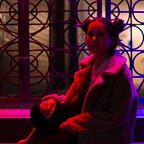Myself and Film
Coming to terms with the filmmaker I have become through the embodiment of films I have consumed.
In late October, I was reflecting on the originality of film stories. I came to the conclusion of how film had been stealing their ideas from other art forms since moving-image media began. With this in mind, it became clear my own identity as a filmmaker was an embodiment of the films, television, music, novels, and stories I’ve enjoyed (or hated) throughout my lifetime. As you can see in my reflection of myself, I have used a variety of film and television to exemplify the influence the art form has had on me. To increase the authenticity of the choices, I decided to use stories that came to my mind without a lot of consideration. I was under the assumption that, if I thought about them as I was creating this video, then perhaps they’re the stories that stood with me the most.
A lot of the television shows seen are from my childhood. This wasn’t a conscious decision, but I feel it’s a decision worth reflecting on. Messenger noticed through her research of television use from children in the 90s, studies showed television was an integral part of a child’s leisure time (Messenger, 2001, p. 21)
“Despite the growing popularity of interactive computer activities among children, television continues to maintain its centrality in children’s lives,” (ibid).
Perhaps this centrality was one of the root causes of my sudden nostalgia trip when creating my self-portrait. It’s become clear how important these programs are to me, and how they may have, perhaps, been the reason I’ve been a fan of anime for all of my life. Without anime, I wouldn’t have been inspired to create comic books, learn to draw, learn to cosplay, learn to sew, or, most importantly, be inspired to write my own stories. Without Sailor Moon, I wouldn’t have created my own extension to their world while I sat next to mum playing bingo every Friday night. Without Studio Ghibli, I wouldn’t have drawn fanciful worlds and wonder about the type of creatures who would live in these worlds. It is thanks to these worlds where I began to think of my own possibilities.
Previously, in my Creative Practitioner vlog, I reflected on my need to improve my divergent and convergent thinking. Throughout high school, I developed freewriting techniques without necessarily understanding the importance of this technique. Peter Elbow tells his readers to freewrite without looking back, to not make corrections or edits, and not to wonder about what words to use (1998, p. 3). This technique, paired with divergent thinking, was something I was inadvertently practising in my teenagerhood. Divergent thinking allows a person to stay in their ideation stages and create ideas without the hindrance of something like criteria or limitations (Harvard Professional Development, 2016). One of the key moments in my late teenager years was the competition, National Novel Writing Month. The task was simple; write 50, 000 words in the month of November. This can be broken down to 1667 words a day, which may sound easy at the surface level. But as someone who was brought up writing for English classes with strange assessment criteria, constricting how you could think, the task was nerve-wracking. As an adult reflecting on these years, I can see how NaNoWriMo has helped my ability to write stories and “go with the flow.” However, I still need to practise redefining my limitations, and therefore using convergent thinking more effectively. One of my questions to myself would be to know and understand what type of limitations I need, and what elements of my story to prioritise.
Another element within my self-portrait is the reference to music and the stories they tell. However, it’s not necessarily the lyrics within the song that I’m drawn to. It’s the magic pull a film’s soundtrack, or score can have on me, that brings me back into the world of the film. Last year, I created a Spotify playlist of songs that drew me back into a film. When I’m doing mundane activities, like cooking, I will put on this playlist and suddenly be transported into the movie. The cleverness and careful construction of a soundtrack is something I would like to one day include in my own streaming television program. Something so clearly part of that world, like the soundtrack to Stranger Things. While this may not necessarily be part of the scriptwriting process, it gives me the desire to stay as part of the writing and development team of my series.
REFERENCES
Elbow, Peter. (1998). Writing without Teachers (2nd ed., pp. 3–11). Oxford University Press, Incorporated.
Harvard Professional Development. (2016). Convergent vs. Divergent Thinking [Video]. Retrieved from https://youtu.be/xjE2RV6IQzo
Messenger, D. M. (2001). ‘dear bbc’ : Children, television storytelling and the public sphere. ProQuest Ebook Central https://ebookcentral.proquest.com
